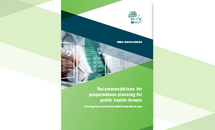#18,402
Eighteen years ago - after H5N1 managed to spread rapidly out of Southeast Asia into Europe, Africa, and the Middle East for the first time - pandemic planning suddenly became a global priority. Nearly every nation (and every U.S. state and Federal Agency) crafted a pandemic plan, and table top exercises and drills were held regularly.Some of these plans, and drills, were better conceived than others, of course. Far too many envisioned a `mild' pandemic, or focused on delivering unlikely-to-be-available vaccines (see No Such Thing As A `Planacea').
A few (out of hundreds of) examples include:
- Hong Kong : Exercise Redwood - 2009
- UK Exercise: PPE Usage In A Pandemic –2008
- Singapore: Public Involvement In Financial Sector Pandemic Drill –2008
- Florida's Pandemic Simulation – 2008
- Idaho BlogEx : July 28th –2008
- UK: Lessons Learned From Winter Willow – 2007
When an influenza pandemic finally did emerge in 2009, it came from a swine H1N1 virus, and was relatively mild (except for those who died from it).
Critics of pandemic planning (which was, admittedly expensive and time consuming) insisted the age of severe pandemics was over (pointing to 3 successively weaker pandemics since 1918), and that modern medicine could more than cope with anything that might emerge.
Although once again from an unexpected source, COVID in 2020 reaffirmed that severe pandemics still happened, and that 10 years after the last pandemic, we were still woefully unprepared to deal with one (see The Most Predicted Global Crisis of the 21st Century).
NIOSH Update: More Fake/Counterfeit N95 Masks Entering Market
JAMA: A Framework for Rationing Ventilators & ICU Beds During the COVID-19 Pandemic
Contemplating A Different `Standard of Care'
HHS ASPR-TRACIE: COVID-19 Crisis Standards of Care Resources
Rather than learn from these mistakes, five years after the start of the COVID pandemic we've dismantled much of our surveillance and reporting systems, in order to declare the emergency ended (see No News Is . . . Now Commonplace).
Worse, the international sharing of emerging disease information is - as near as I can tell - the most dysfunctional its been since I began this blog nearly 20 years ago (see The Wrong Pandemic Lessons Learned).
While the world appears to be sleepwalking towards the next global health crisis, we've seen some movement. Last summer both South Korea and Japan issued revised pandemic plans, and last November Hong Kong held a Coordinated Avian Flu Drill `Amazonite'.
- In 2023 Japan announced plans to stockpile about 10 million doses.
- The United States ordered about 4.8 million doses last summer, enough for about 2.4 million people.
- The EU announced plans to acquire 650,000 doses
- Last December the UK announced plans to purchase 5 million doses,
- Six weeks ago Canada PHAC Announces Plans To Purchase 500,000 doses Of H5N1 Vaccine.
Over the past year the ECDC has been busy issuing guidance documents to its member nations. Like with our own CDC - these are not mandates, only recommendations - and it is up to each individual public health entity to decide what to incorporate in their planning.
While most of this recent surge in preparedness is likely inspired by the continued spread of H5N1, the reality is we could easily be blindsided (again) by something other than avian flu with the next pandemic.
Just over a year ago (March 20th, 2024) we looked at the first part of this 2-part plan (see ECDC Guidance: Public Health and Social Measures for Health Emergencies and Pandemics in the EU/EEA), which was published less than a week before the announcement of H5N1 in American livestock.
I've only included the link and executive summary of this 49-page installment. Follow the link to read it in its entirety. I'll have a bit more after you return.
Over the past year, PAHO (Pan American Health Organization) has repeatedly urged its member nations to proactively prepare to deal with a potential influenza pandemic. While H5N1 is assumed, it could certainly be from another coronavirus (or something entirely unexpected).
Just over 4 months ago, in A Personal Pre-Pandemic Plan, I wrote about the practical things you and your family can do now to prepare for a possible pandemic in the months or years ahead.
While I still hope we can avoid (or at least delay) that eventuality, the simple truth is, preparedness is always easier before the next emergency starts.
And the clock is always ticking.

